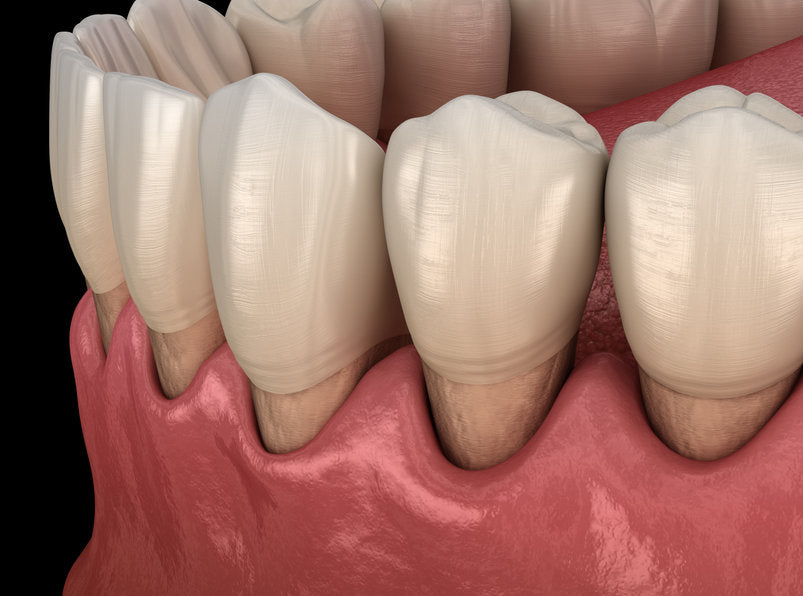
Did you know there are five sides to a tooth—the distal, facial, incisal, lingual, and mesial? When you brush your teeth, you only reach three of those five. Brushing is necessary to prevent cavities and plaque from building up along your teeth. But without the other necessary component, flossing, the other two sides of your teeth go untouched. That leaves food particles and bacteria behind which will irritate the gums and create an inflammatory response.
What is gum recession? Gum recession is the slow degradation of your gum line. As the gum shrinks away and exposes more of the tooth, gum pockets form making it easier for bacteria to get caught. Even mild gum recession is important to catch early to prevent the receding gumline from snowballing out of control.
ToothShower Oral Suite On Amazon
Causes of Gum Recession
As a kid, the advice you probably heard was if you have good oral hygiene, then you’ll be gum disease-free and never have to worry about going to the dentist. Today, we are finding out that this is not the case. There are several reasons gum recession occurs, including:
- Periodontal disease
- Genetics
- Insufficient dental care
- Tobacco
Periodontal Disease
Also known as periodontitis, periodontal disease is a bacterial infection of the gums, alveolar bone, or periodontal ligament. If the bacterial infection is in the gums, one of the notable signs is gum recession. Without treatment, the end stage of periodontal disease is the complete degradation of gums and loss of teeth.
To avoid this outcome, periodontitis can be treated by a professional cleaning, proper self-care and oral hygiene, or with a combination of cleaning and antibiotics.
Genetic Predisposition to Gum Disease
The reason why oral hygiene isn’t the full picture is that it doesn’t take into account genetics. Much like how some people are more prone to Alzheimer’s or Diabetes, the same goes for periodontitis. In 2015, researchers provided a link between the Interleukin-6 Gene and periodontal disease.1 This polymorphic gene can play a huge factor in gum recession and the formation of gum pockets.
Although it’s important to add, even if you are genetically predisposed to gum disease, having proper hygiene will delay the symptoms and effects.
Insufficient Dental Care
As you’ve probably surmised, dental care is a crucial contributor to whether or not you develop gum disease. That includes:
- Avoiding aggressive toothbrushing – Did you know that you can experience gum recession from brushing your teeth? Gums are sensitive, they can degrade, and they don’t regenerate. This means if you aggressively brush your teeth, you wear and tear at the gum lines, creating the gum pockets yourself.
- Flossing – The number one dreaded question at the dentist: “Do you floss?” The responses have always baffled oral hygienists. If every dentist stresses the importance of flossing, why do most people avoid it? The problem, some believe, comes from the tools themselves. Most people still use string floss, which is difficult and time-consuming. Using a water flosser is one way to fix that.
- Massaging of gums – Another way to upgrade your dental care is to massage your gums. This helps manually break apart biofilms building on your gums and at the base of your teeth. It also stimulates blood circulation, which helps boost the immune response.
Gum Recession With Braces
If you’ve ever lived with metal in your mouth, you know how hard it is to clean your teeth. And flossing with braces? Forget about it. Gum recession from braces is a common occurrence because of the difficulty of providing your teeth with sufficient dental care. Try using water-powered oral tools by ToothShower, to make cleaning easy and to avoid gum recession caused by braces.
Tobacco Products
Cigarettes and chewing tobacco are known to have significant, adverse effects on the health of your tongue, teeth, and gums. Something like chewing tobacco where the nicotine sits right on the gumline is especially harmful. The CDC reports that smokers are twice as likely to develop gum disease and gum recession than nonsmokers.2
Preventing Gum Recession
Even gum recession on one tooth can be enough to cause significant pain and warrant dental intervention. So, now that the question “what is gum recession?” has been answered, let’s discuss gum recession home treatment.
- Flossing and massaging – After brushing your teeth, don’t forget the other two components of proper oral hygiene.
- Mouthwash – To kill all the bacteria before you go to bed, use an over the counter brand mouthwash with the active ingredient: cetylpyridinium chloride.
- Hydro-powered oral care – If you’re someone who doesn’t clean their teeth to the degree they should, try water-powered oral care products. Water flossers are easy to use and can be placed right in your shower!
- Veneers gum recession – Much like using tooth veneers to protect your teeth, gum veneers can slow gum recession and protect your gums.
Gum Recession Electric Toothbrush: Is There a Link?
The main “gum recession electric toothbrush” link harkens back to aggressive toothbrushing. The electric toothbrush already provides the necessary scrubbing movement, so all you have to do is drag the bristles along your teeth and gums in a gentle movement. However, when people treat it as a manual toothbrush, it can cause extensive damage to their gums.
Once your gums have been compromised, it will be hard to reverse its effects with just a brush and floss. For more information on gum recession treatment, visit our website or talk to one of our experts at ToothShower today.
Sources:
1. Journal of Biological Regulators & Homeostatic Agents. Interleukin-6 Gene Polymorphism Modulates The Risk of Periodontal Diseases. https://boa.unimib.it/retrieve/handle/10281/93771/137538/253%20NTERLEUKIN-6%20GENE%20POLYMORPHISM%20MODULATES%20THE%20RISK%20OF.pdf
2. CDC. Smoking, Gum Disease, and Tooth Loss. https://www.cdc.gov/tobacco/campaign/tips/diseases/periodontal-gum-disease.html
The post What Is Gum Recession? appeared first on ToothShower.


Leave a comment (all fields required)